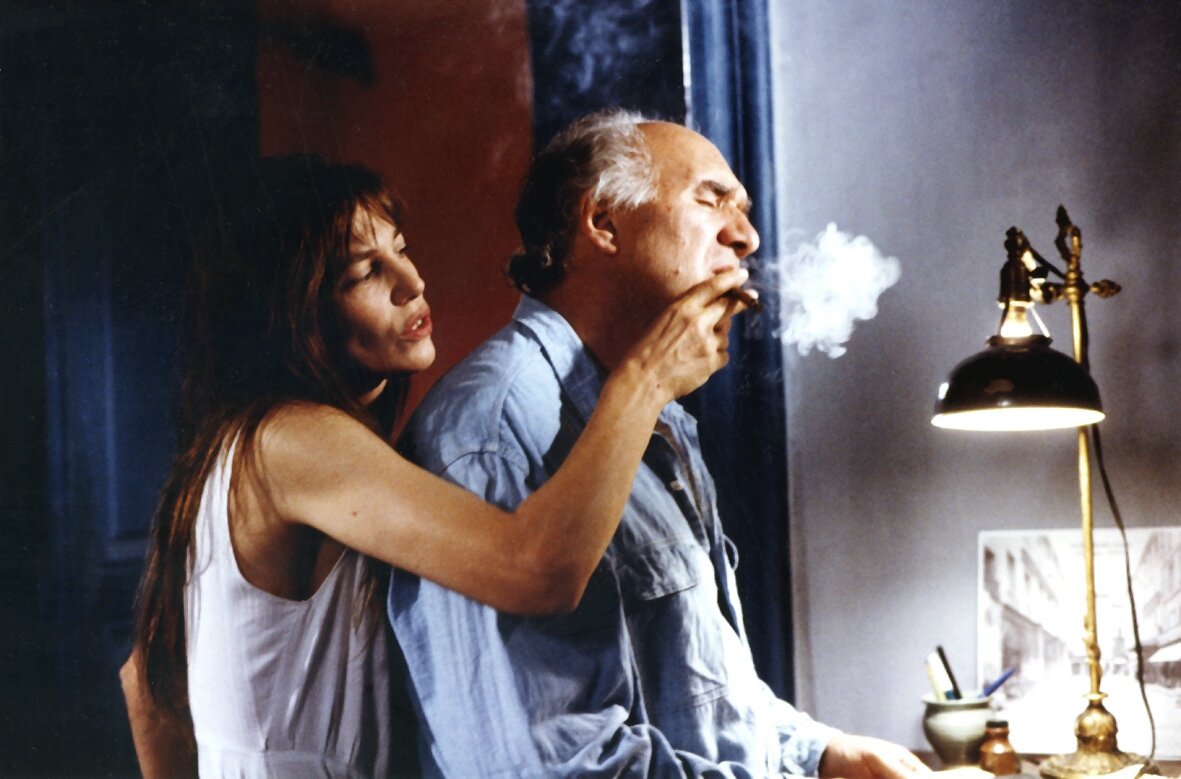The Beautiful Troublemaker | France | 1991 | Directed by Jacques Rivette
Logline: When a young artist and his girlfriend visit an ageing painter and his wife, the younger woman inadvertently becomes the painter’s new muse.
Inspired by a novella, Le Chef-d'oeuvre Inconnu (The Unknown Masterpiece) by Balzac, La Belle Noiseuse existed as a director’s treatment with no script per se, but dialogue was written by Pascal Bonitzer and Christine Laurent. It’s a carefully sculpted study of love and art, of truth and secrecy, of honesty and duplicity. It is one of the few movies to come close to capturing the essence, from preliminary sketch to completed painting, of the painter’s process as artist.
Edouard Frenhofer (Michele Piccoli) is a semi-retired, once famous painter living a peaceful, reflective life in his beautiful Provence countryside estate, with his wife Liz (Jane Birkin), and a young maid (Leila Remili). Nicolas (David Burszstein) arrives with Mariannae (Emmanuelle Béart), along with Porbus (Gilles Arbona), Frenhofer’s agent. Porbus wants new art, but Frenhofer is reluctant, elusive. Nicolas, the budding artist, is restless, and Marianne is ripe. Half-jokingly Nicolas and Porbus suggest that Marianne be Frenhofer’s model, to stir the artist’s creative juices again.
When Marianne finds out she’s been offered as an objet d’art she is incensed with Nicolas and his assumption that she would happily do such a thing. But at the crack of dawn the next morning she offers herself, partly in spite, partly in curiosity. But the provocateur is quickly seduced by Frenhofer’s casual intensity, as the aging painter admires her natural beauty, especially once she is sans clothes - au naturale - and is able to gently contort her into poses sensual and provocative.
The veteran artist commences work on the painting he abandoned long ago: “La Belle Noiseuse”. Marianna has now replaced his original muse, Liz, and a struggle for truth, life and sense begins, as the question of where the limit of art lies, or whether art is, in fact, limitless burns through the fabric of resistance. Marianne yearns to discover Frenhofer’s creative secrets, yet it is the artist who probes invisibly, deeper and deeper inside the young woman, extracting another person entirely.
The movie ebbs and flows at a languid, truly leisurely pace, coming in at an epic three hours and forty minutes, but was also released in a 125 minute-version, using alternate takes, employing a different rhythm, and featuring less nudity under brighter lighting. This version was designed for French television and was re-titled Divertimento. I’ve not seen it, but am curious as to how different the overall experience would be.
Elegantly directed and sumptuously shot, entirely on location, La Belle Noiseuse is a quietly powerful treatise on the relationship between artist and model, between what is genuine and what is fake; in emotion, psyche, physicality, and ultimately in expression, yet remains as elusive as the spark of imagination. Masterfully understated, gloriously uninhibited, the film, and the mesmerising performance of Emmanuelle Beart, remains an undeniably bold and beautiful cinema statement of artistic nuance and a celebration of nude female pulchritude.




